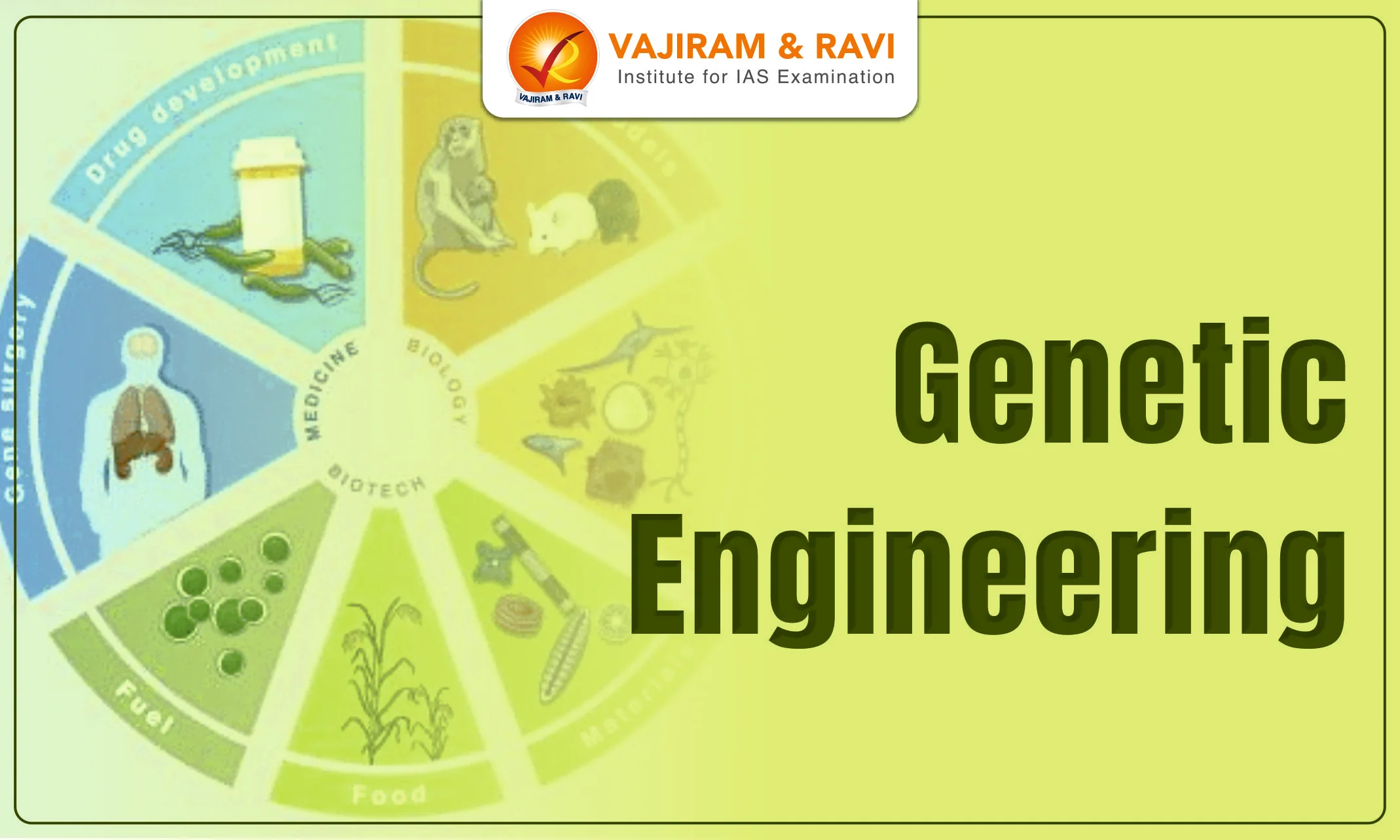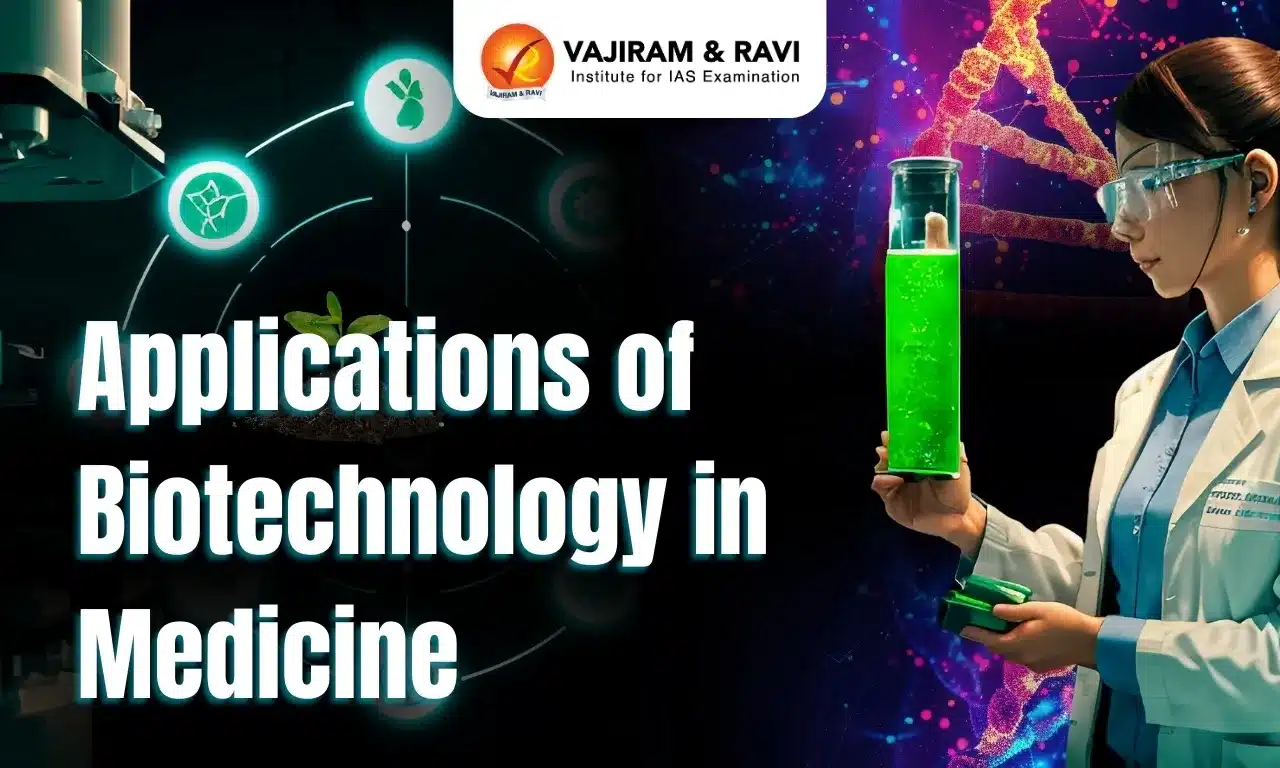Genetic engineering refers to the direct manipulation of an organism's genome using advanced DNA technology. It involves the introduction, deletion or modification of genes within an organism's DNA to produce desirable traits. Genetic engineering has revolutionised fields like agriculture, medicine and biotechnology enabling innovations like disease-resistant crops, synthetic insulin production and gene therapy.
The field of genetic engineering has been propelled by advancements in gene editing technologies such as CRISPR-Cas9, in recent years. Gene editing technologies have revolutionized the ability to manipulate genes, allowing scientists to precisely modify and control genetic material.
Objectives and Approaches of Genetic Engineering
Genetic manipulation aims to achieve the following key objectives:
- Creating New Genes: Novel gene sequences for a particular product (protein) may be synthesised and introduced into target organism genomes.
- Recombinant DNA technology is primarily used for this objective.
- Silencing Target Genes: The expression of specific genes can be selectively silenced without altering DNA itself, effectively abolishing their action (without knocking out the gene).
- RNA interference and other Gene knockdown methods are used for this objective.
- Removing one or more specific genes: The expression of a gene can be removed completely by the use of genetic engineering. It is mainly used for studying and modelling different types of diseases and their metabolic pathways.
- Recombinant DNA technology and its most recent innovations like CRISPR/Cas 9 technology is preferably used for this purpose.
- Editing Gene Function: Gene editing allows the precise modification of a particular gene and thereby its expression to control subsequent biochemical processes. It is used for studying gene and gene therapy.
- Nowadays, CRISPR/Cas 9 technology is used for the gene editing objective.
Methods Used in Genetic Engineering
There are different ways to artificially modify the traits and genomes of organisms by adding, deleting or editing genes. Some of the most commonly used methods of genetic engineering are:
- Recombinant DNA Technology: This method involves taking a gene, putting it into a vector like a virus or plasmid, and adding it to the DNA of a target organism. This allows the transfer of desired genes between different species.
- For example, genes coding for drought tolerance from resilient plant species can be transferred to susceptible crop varieties to make them more drought-resistant.
- Steps in recombinant DNA production:
- Isolation of genetic material.
- Cutting of DNA at specific locations.
- Joining of DNA fragments by ligation and homopolymer tailing.
- Insertion of DNA into the host cell.
- Selection and screening of transformed cells.
- Gene editing: It is the precise modification of the genetic code to cure genetic diseases or provide advantageous characteristics.
- CRISPR/Cas9 technology is a gene editing tool that allows for the precise removal and addition of genes in an organism's DNA.
- For example, the gene causing sickle cell anaemia can be edited to rectify the mutation and restore normal haemoglobin function.
- Gene knockout is the deactivation or deletion of specific genes by cutting DNA at targeted regions to research gene function.
- CRISPR/Cas9 technology is a gene editing tool that allows for the precise removal and addition of genes in an organism's DNA.
- Gene Silencing/ Gene Knockdown: This method involves turning off specific genes using RNA interference, short complementary nucleotide sequences like siRNA, miRNA and antisense RNA without editing the actual DNA code.
- This is used to study the function of unknown genes and develop treatments for diseases.
- For example, silencing genes that enable virus replication in host plants can generate virus-resistant plant varieties.
- Protoplast fusion: This method involves fusing cell wall-free plant protoplasts using chemical or electrical means.
- The hybrid cell lines with mixed genomes are then regenerated, which can introduce disease or stress resistance, improve quality parameters in horticultural species and are also used in synthetic seed production.
- Protoplast fusion has been used to produce fungus-resistant potatoes, high-quality seedless grapes etc.
Applications of Genetic Engineering
Genetic engineering has thus resulted in different kinds of vaccines, antibodies and vitamins, drugs and hormones which are easily available in the market and are involved in the treatment of many diseases.
Therapeutics or Medicinal Applications of Genetic Engineering
- Cancer therapeutics: New immunotherapy can be developed using genetic editing that can treat cancer. Modification of T-cells using CRISPR can locate and kill cancer cells.
- Drug research: Genetic makeup can potentially speed up the drug discovery process. Some of the drug makers are already incorporating CRISPR technology in the drug research and discovery phase.
- Gene therapy: Some genetic disorders caused by single-gene defects, such as cystic fibrosis, muscular dystrophy, haemophilia, sickle cell anaemia and AIDS can be treated by gene therapy approach.
- Synthesising hormones and enzymes: Through recombinant DNA techniques, bacteria have been created that are capable of synthesising human insulin, human growth hormone, alpha interferon, a hepatitis B vaccine, and other medically useful substances.
- Plants breed improvement: Plants may be genetically adjusted to enable them to fix nitrogen and correct genetic diseases by replacing dysfunctional genes with the use of genetic technology.
Industrial Application of Genetic Engineering
- Protein synthesis: Itincludes transforming microorganisms such as bacteria or yeast, or insect mammalian cells with a gene coding for a useful protein.
- Mass quantities of the protein can be produced by growing the transformed organism in bioreactors using fermentation.
- Recombinant enzymes: Enzymes are involved in the fermentation and digestion of foods.
- This has led to the concept of the production of recombinant enzymes from genetically modified microbes such as chymosin and lipase for cheese production, and alpha-amylase for flavour enhancement in the beer industry.
Agriculture Applications
- Transgenic Plants / Animals are designed as a result of alteration of the genetic makeup of the organism to develop desirable traits such as high yield variety, suppressing particular vulnerabilities or disease etc.
- Crop traits improvement: Genetic engineering is used in agriculture to create genetically modified crops (GM crops) such as BT-cotton, which is resistant to pest attack.
Disadvantages of Genetic Engineering
Genetic engineering has the potential to address genetic disorders and climate change. However, ethical concerns arise from its unintended consequences and malicious use. Some of these ethical considerations include:-
- Ethical dilemmas and social implications: The progress of genetic engineering has led to ethical dilemmas that require us to balance the desire for scientific advancement with concerns about equity, consent, and long-term consequences.
- There is a debate about whether it is ethical to modify the human germline, create genetically modified organisms (GMOs), and the potential for genetic discrimination.
- Germline interventions: Genetic engineering can alter the genome of every cell in a person's body, potentially impacting subsequent generations without their consent. This cross-generational impact raises ethical issues and technical limitations.
- For example, unintended mutations can occur, resulting in permanent off-target edits and mosaicism.
- Moreover, there is a risk of creating "designer babies" engineered for enhancement rather than therapy, which raises concerns about ethical boundaries.
- Ownership and access: There is a need to balance innovation incentives and access when it comes to genetically engineered organisms, genes, or cell lines.
- This requires appropriate licensing scopes and regulatory structures that balance rapid, widespread access with the ethics of informed consent for genetic testing and editing interventions.
- Privacy: Preventing discrimination based on individuals' genomic data is crucial.
- Ecological impacts:
- Gene Flow is the transfer of genetically engineered genes between plant species through cross-pollination or horizontal gene transfer to soil microorganisms.
- If herbicide resistance genes from GM crops move to weed species, it can negatively impact crop productivity and ecosystem balance.
- Gene Drives can spread engineered genes quickly in wild populations. But using them to eradicate invasive species is risky. Unanticipated effects could permanently modify ecosystems.
- Eliminating a keystone species could lead to dependent organisms dying out and permanent biodiversity loss.
- Impact on wild variety: Uniform, high-yield crop varieties can reduce genetic diversity in wild ancestral varieties via uncontrolled hybridization. Loss of diversity weakens crop resilience.
- In India, GM cotton hybrids left wild varieties vulnerable. Conserving wild germplasm is crucial for future crop enhancement.
- Gene Flow is the transfer of genetically engineered genes between plant species through cross-pollination or horizontal gene transfer to soil microorganisms.
Precautions
Dilemmas related to genetic engineering require the establishment of ethical guidelines and oversight frameworks that balance innovation with appropriate precautions. These precautions include the following:
- Transparent research: There should be common standards for rigour, efficacy, and safety, with registered and regulated trials, and accessibility of data for reproducible analyses.
- For example, all human gene editing trials should be registered in an open database, peer-reviewed, and subjected to oversight by ethics committees and regulatory authorities.
- Informed consent: Genetic literacy should be improved to ensure that individuals can make voluntary and informed decisions regarding the potential risks and benefits of genetic testing and interventions.
- For example, clear communication of possibilities like off-target effects or mosaicism in embryo editing is needed during IVF counselling.
- Benefit-sharing: Economic benefits from commercial products developed using indigenous genetic material must be distributed equitably.
- Royalty transfers under access and benefit-sharing agreements to compensation communities preserving rare medicinal plant genetic diversity.
- Biosafety reviews: Strict containment and stepwise field testing must be conducted to evaluate the environmental and ecological impacts of all genetically engineered organisms with the capacity to spread autonomously.
- For example, gene-driven organisms need robust multi-generational testing to predict stability in target populations and minimise irreversible ecosystem harm.
| Related Topics: | |
| GAGAN | Genome Sequencing |
| 3D Printing | LiFi |
| Machine Learning | Vikram Sarabhai |
| Deep Learning | Subrahmanyan Chandrasekhar |
| Indian Neutrino Observatory (INO) | Satyendra Nath Bose |
Last updated on January, 2026
→ Check out the latest UPSC Syllabus 2026 here.
→ Join Vajiram & Ravi’s Interview Guidance Programme for expert help to crack your final UPSC stage.
→ UPSC Mains Result 2025 is now out.
→ UPSC Notification 2026 Postponed for CSE & IFS which was scheduled to be released on 14 January 2026.
→ UPSC Calendar 2026 has been released.
→ UPSC Prelims 2026 will be conducted on 24th May, 2026 & UPSC Mains 2026 will be conducted on 21st August 2026.
→ The UPSC Selection Process is of 3 stages-Prelims, Mains and Interview.
→ Prepare effectively with Vajiram & Ravi’s UPSC Prelims Test Series 2026 featuring full-length mock tests, detailed solutions, and performance analysis.
→ Enroll in Vajiram & Ravi’s UPSC Mains Test Series 2026 for structured answer writing practice, expert evaluation, and exam-oriented feedback.
→ Join Vajiram & Ravi’s Best UPSC Mentorship Program for personalized guidance, strategy planning, and one-to-one support from experienced mentors.
→ UPSC Result 2024 is released with latest UPSC Marksheet 2024. Check Now!
→ UPSC Toppers List 2024 is released now. Shakti Dubey is UPSC AIR 1 2024 Topper.
→ Also check Best UPSC Coaching in India
Genetic Engineering FAQs
Q1. What is Genetic Engineering?+
Q2. What are the various tools employed for Gene editing?+
Q3. What are the potential applications of Genetic engineering?+
Q4. What is the difference between Gene knockdown and Gene knockout?+
Tags: genetic engineering quest


















